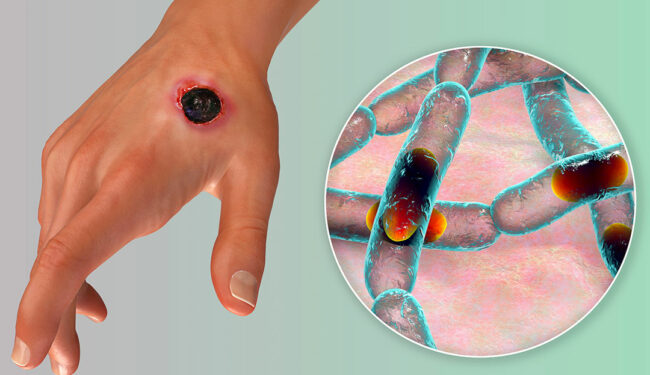Nigeria reported its first anthrax outbreak on Monday, July 17 a few weeks after the federal government warned Nigerians against the consumption of hides (ponmo) as well as smoked and bush meat.
This was contained in a statement with subject ‘CONFIRMATION OF FIRST ANTHRAX CASE IN NIGERIA’, signed by the Permanent Secretary, Federal Ministry of Agriculture and Rural Development, Dr Ernest Umakhihe.
Umakhihe in confirming the first case said it was detected in Niger, close to the Federal Capital Territory, FCT, on a farm and confirmed on Sunday, July 16, 2023, by the National Veterinary Research Institute (NVRI)-Vom, Plateau State.
Anthrax can be deadly, and on a large scale – in 1770, an epidemic that killed 15,000 people in what is now Haiti is thought to have been intestinal anthrax caused by uncooked beef.
Here’s what you need to know about the disease.
Anthrax can stay hidden for years
Anthrax is caused by a bacterium called Bacillus anthracis that occurs naturally in soil. One of the reasons it is such a threat is because the bacteria can stay dormant as highly resistant spores in the soil that can be brought to the surface by rain or tilling the fields. When these spores are eaten by animals they cause an outbreak.
How it spreads
Anthrax is not contagious, which means an infected person can’t pass it on to others like a cold or flu. However, people can get sick with anthrax if they come into contact with infected animals or contaminated animal products, and spores get cuts or scrapes on the person’s skin. Thus it often infects veterinarians, agricultural workers, livestock producers, or butchers. Eating raw or undercooked meat from an infected animal or drinking contaminated water can cause the disease. Anthrax can spread through the air, where the spores are inhaled, which can happen in places like slaughterhouses and tanneries.
Its fatality
There are different types of anthrax symptoms depending on whether the spores enter the skin (cutaneous anthrax), are breathed in (inhalation anthrax), are eaten or drunk (gastrointestinal anthrax), or injected (injection anthrax).
When anthrax spores get inside the body, the bacterium goes from dormant to active and multiplies, spreading through the body, producing toxins.
Symptoms of cutaneous anthrax include blisters and sores on the skin, inhaling the spores can cause chest pains, shortness of breath and cough, and gastrointestinal anthrax can mean swelling of the neck, sore throat, bloody vomiting or diarrhoea.
Inhaled anthrax usually develops a few weeks after exposure but it can take up to two months. Without treatment, most people die – even with aggressive treatment, it kills one in two people.
Without treatment, up to 20% of people with cutaneous anthrax die. If left untreated, more than half of patients with gastrointestinal anthrax die. However, treatment can save 60% of people.
A deadly bioweapon
Anthrax spores are not only easily found in nature, they can be produced in a lab. The spores can be made into powders, sprays or dissolved into water or food, and can be impossible to detect through smell or taste.
Anthrax has been deployed as a weapon around the world for nearly a century and was used in both World Wars.
Treatment
The standard treatment for anthrax is an antibiotic such as ciprofloxacin or doxycycline. Since some spores can take up to two months to be activated, people need to take antibiotics for that long to be sure they are protected.
The anthrax vaccine adsorbed (AVA) can be given as a preventive for people who are particularly high risk and can also be given post-exposure along with antibiotics.
TRIBUNE




